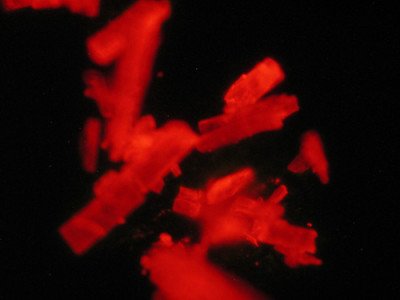Drugs (Legal & Illicit)
Drugs include a wide variety of compounds including legal and illicit compounds as well as a wide variety of vegetable drugs. Microtrace maintains a DEA license that permits analysis of drugs from all schedules (1, 2N, 3, 3N, 4, and 5), which includes all controlled substances. Such analyses are are typically conducted by PLM, FTIR, and GC-MS.
Forensic Identification and Case Reviews
Drug identification ranges from the examination of white powders, unknown tablets, and capsules to the identification of residues encountered in alleged product contamination cases. More recently, we have been contacted to investigate the actual content of supplements such as HGH and counterfeit (foreign) pharmaceuticals obtained without prescriptions. While in some cases, a basic identification of the material is sufficient, in others, it may be necessary to determine if the active ingredient is a base or hydrochloride or to identify the specific polymorph. In other instances, the identification of fillers, diluents, or excipents may be relative to the case.
Although we routinely perform laboratory analyses of drugs, we also assist investigators and attorneys with the scientific review of opposing experts data and conclusions.
Product Contamination and Trace Residues
In some circumstances, only a trace of drug remains in the bottom of a product or there is only an allegation that a drug is present. In these cases, Microtrace has had great success searching for and definitively identifying the presence or abscence of an active ingredient. In some cases, we have been able to identify a particular brand of product based on remaining residue.
Quantification
In most cases, we have found that qualitative identification is sufficient; however, in some instances, quantification of active ingredients in both solid and liquid forms is relevant. Such cases arise in instances of poisoning, counterfeit products, or in cases of product failure. In many of these instances quantification is possible.
Characterization
We assist clients in the pharmaceutical industry by characterizing the optical properties of drugs and their polymorphs (such as refractive index) as well as their spectroscopic properties. On a more basic level, we can identify active ingredients, determine particle size distribution, and evaluate the distribution of components within a tablet.
Product Contamination and Adulteration
Sometimes a consumer may allege a product is contaminated with a pharmaceutical. First, the material is examined to determine if it is a pharmaceutical. Then, the material is analyzed to determine the active ingredient. Finally, the remaining product and production packing is examined for evidence of the pharmaceutical. These examinations and analyses can help determine when the pharmaceutical came into contact with the product.
Related standardized methods: ASTM E1298, E1968, E1969, E2326, E2327, E2329, E2363, E2500, E2537, E2548, E2549, E2764
How May We Help You?
Contact usto discuss your project in more detail.








